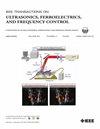矩阵阵列体积超声成像的定向相干系数。
IF 3.7
2区 工程技术
Q1 ACOUSTICS
IEEE transactions on ultrasonics, ferroelectrics, and frequency control
Pub Date : 2025-04-03
DOI:10.1109/TUFFC.2025.3557519
引用次数: 0
摘要
小孔径矩阵阵列限制了体积超声成像的空间和对比度分辨率。基于相干的波束形成器在抑制旁瓣和提高分辨率方面非常流行。虽然矩阵阵列的空间相干性基本上是一个二维函数,但传统的相干因子(CF)方法在计算体积相干性时忽略了M × N矩阵阵列的方向变化。我们在此提出了一种基于投影的定向相干因子(DCF)来利用体积相干函数的二维特性。DCF不是计算整个二维孔径的相干和非相干总和,而是将孔径数据投影到方位角、仰角、对角线和反对角线方向,然后分别计算每个方向的相干系数。将正交相干对(方位角和仰角、对角和反对角)相乘,分别得到DCFRC和DCFDiag。利用dfrc和DCFDiag的Jaccard相似度推导出最终的DCF,对重构图像进行加权。我们评估了DCF波束形成在点目标模拟、多用途幻影实验和体内肌肉成像中的性能,并将其与延迟和(DAS)和CF波束形成进行了比较。与传统的CF相比,我们的DCF在整个体积中实现了旁瓣的减少。此外,对角线加权显著提高,平均而言,方位角分辨率比DAS高41.3%,比CF高7.35%,高度分辨率比DAS高40.4%,比CF高38.7%。我们提出的DCF为二维矩阵阵列配置的体积成像分辨率和对比度增强提供了一个实用的解决方案。本文章由计算机程序翻译,如有差异,请以英文原文为准。
Directional Coherence Factor for Volumetric Ultrasound Imaging With Matrix Arrays
Matrix arrays with small apertures limit spatial and contrast resolutions of volumetric ultrasound imaging. Coherence-based beamformers are prevalent for sidelobe suppression and resolution improvement. While the spatial coherence of a matrix array is fundamentally a 2-D function, conventional coherence factor (CF) methods neglect the directional variation of an ${M} \times {N}$ matrix array when calculating volumetric coherence. We hereby propose a projection-based directional CF (DCF) to exploit the 2-D nature of volumetric coherence function. Instead of computing the coherent and incoherent summations across the entire 2-D aperture, DCF projects aperture data onto azimuthal, elevational, diagonal, and anti-diagonal directions and subsequently calculates the CFs for each direction separately. The orthogonal coherence pairs, i.e., azimuth and elevation, and diagonal and anti-diagonal, are multiplied to obtain DCFRC and DCFDiag, respectively. The Jaccard similarity of DCFRC and DCFDiag is used to derive the final DCF to weigh the reconstructed images. We evaluated the performance of DCF beamforming in point-target simulations, multipurpose phantom experiments, and in vivo muscle imaging and compared it to delay-and-sum (DAS) and CF beamformers. Our DCF achieved sidelobe reduction throughout the entire volume compared to conventional CF. Moreover, diagonal weighting significantly improved, on average, the azimuthal resolution by 41.3% versus DAS and 7.35% versus CF as well as the elevational resolution by 40.4% versus DAS and 38.7% versus CF. Our proposed DCF offers a practical solution for resolution and contrast enhancement of volumetric imaging in 2-D matrix array configurations.
求助全文
通过发布文献求助,成功后即可免费获取论文全文。
去求助
来源期刊
CiteScore
7.70
自引率
16.70%
发文量
583
审稿时长
4.5 months
期刊介绍:
IEEE Transactions on Ultrasonics, Ferroelectrics and Frequency Control includes the theory, technology, materials, and applications relating to: (1) the generation, transmission, and detection of ultrasonic waves and related phenomena; (2) medical ultrasound, including hyperthermia, bioeffects, tissue characterization and imaging; (3) ferroelectric, piezoelectric, and piezomagnetic materials, including crystals, polycrystalline solids, films, polymers, and composites; (4) frequency control, timing and time distribution, including crystal oscillators and other means of classical frequency control, and atomic, molecular and laser frequency control standards. Areas of interest range from fundamental studies to the design and/or applications of devices and systems.

 求助内容:
求助内容: 应助结果提醒方式:
应助结果提醒方式:


